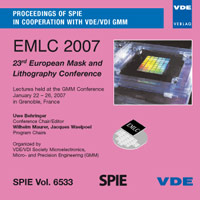Programmed Defects Study on masks for 45nm Immersion Lithography using the novel AIMS(TM)45-193i
Konferenz: EMLC 2007 - 23rd European Mask and Lithography Conference
22.01.2007 - 26.01.2007 in Grenoble, France
Tagungsband: EMLC 2007
Seiten: 9Sprache: EnglischTyp: PDF
Persönliche VDE-Mitglieder erhalten auf diesen Artikel 10% Rabatt
Autoren:
Scherübl, Thomas; Böhm, Klaus; Birkner, Robert; Richter, Rigo; Strößner, Ulrich (Carl Zeiss SMS GmbH)
Dürr, Arndt C. (Advanced Mask Technology Center GmbH & Co. KG)
Inhalt:
Mask manufacturing for the 45nm node for hyper NA lithography requires tight defect and printability control at small features sizes. The AIMS(TM)1 technology is a well established methodology to analyze printability of mask defects, repairs and critical features by scanner emulation. With the step towards hyper NA imaging by immersion lithography the AIMS(TM) technology has been faced with new challenges like vector effects, polarized illumination and tighter specs for repeatability and tool stability. These requirements pushed the development of an entirely new AIMS(TM) generation. The AIMS(TM) 45-193i has been designed and developed by Carl Zeiss to address these challenges. A new mechanical platform with a thermal and environmental control unit enables high tool stability. Thus a new class of specification becomes available. The 193nm optical beam path together with an improved beam homogenizer is dedicated to emulate scanners up to 1.4 NA. New features like polarized illumination and vector effect emulation make the AIMS(TM) 45-193i a powerful tool for defect disposition and scanner emulation for 45nm immersion lithography. In this paper results from one of the first production tools will be presented. Aerial images from phase shifting and binary masks with different immersion relevant settings will be discussed. Also, data from a long term repeatability study performed on masks with programmed defects will be shown. This study demonstrates the tool’s ability to perform defect disposition with high repeatability. It is found that the tool will fulfill the 45nm node requirements to perform mask qualification for production use.


